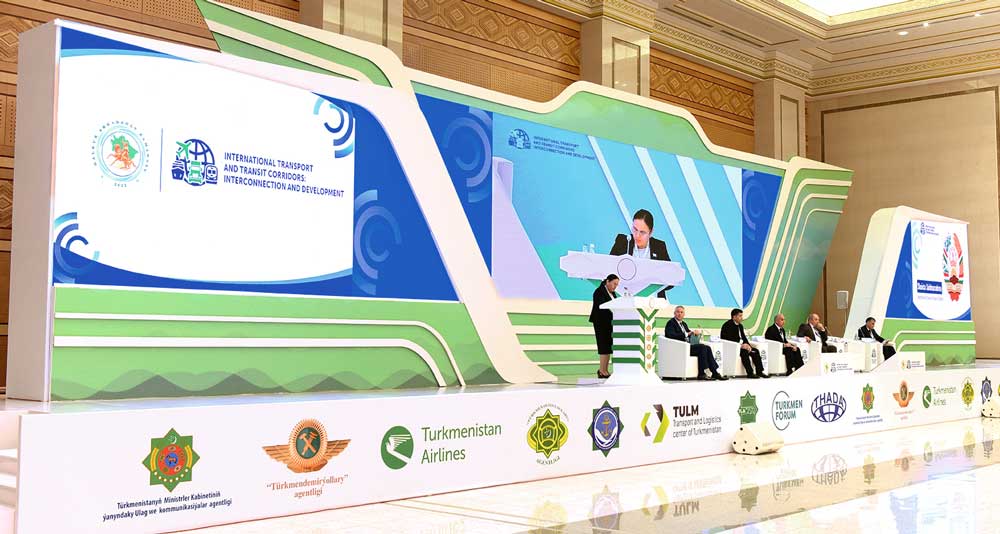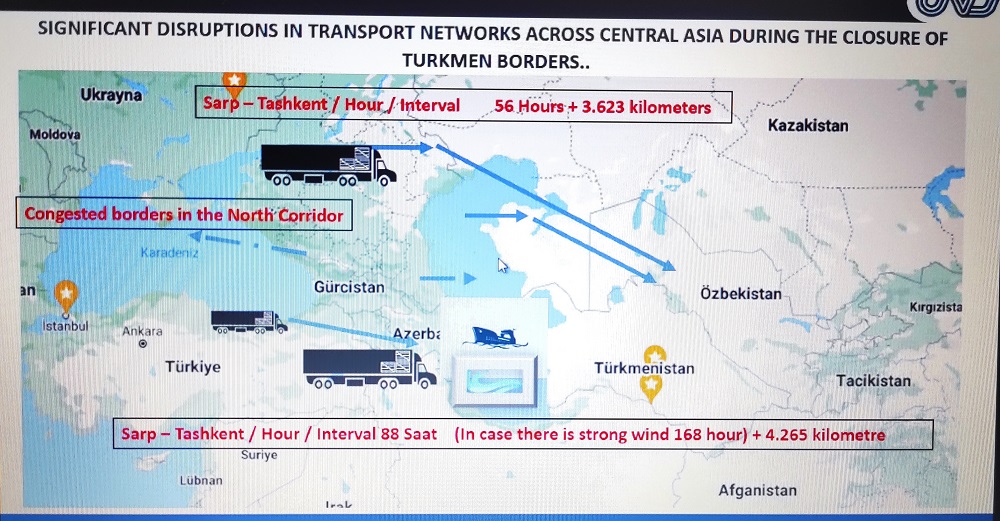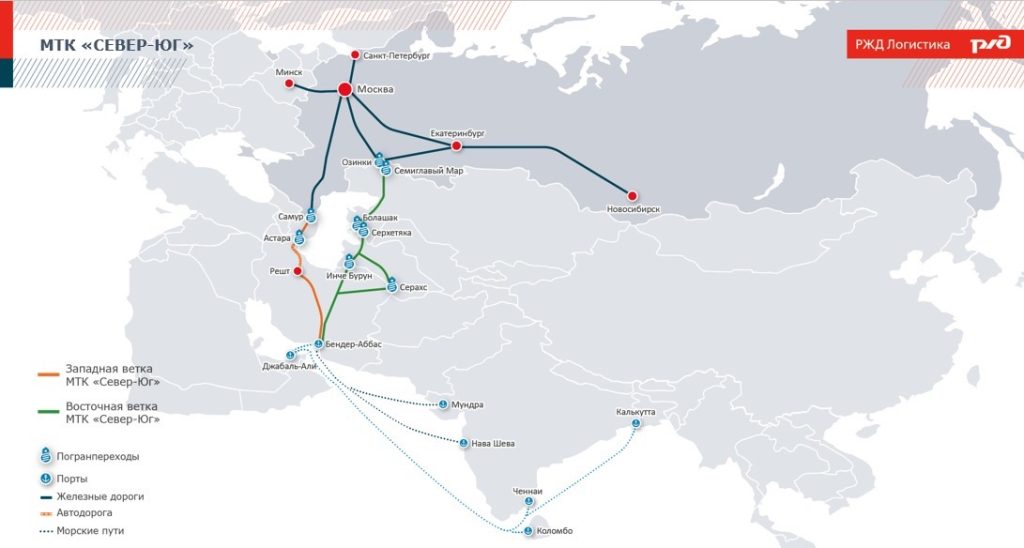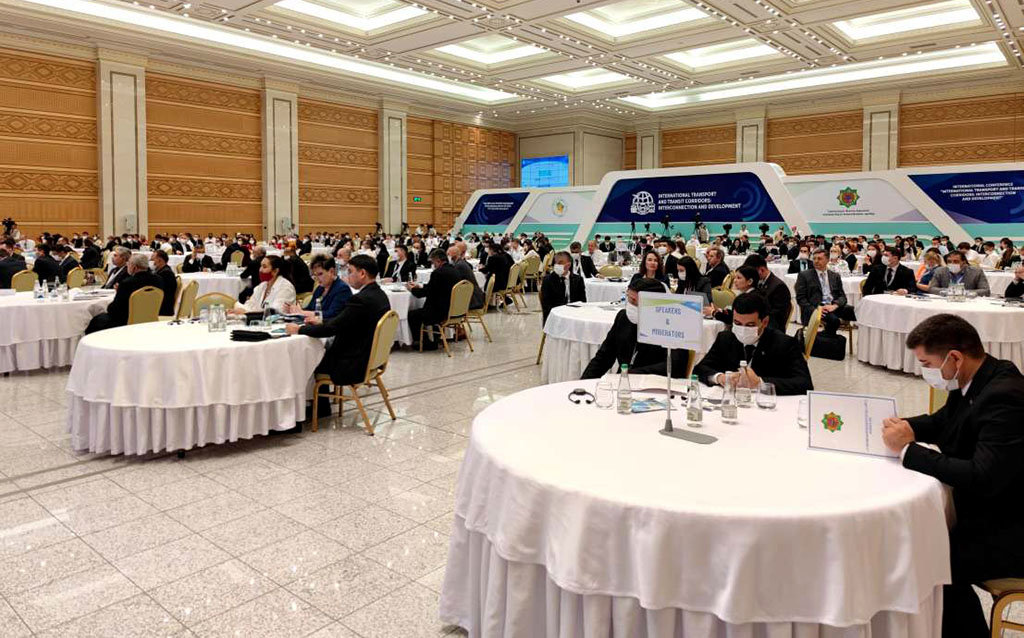Elvira Kadyrova
In the modern world, which has survived the challenges of the pandemic and political upheavals, the geography of transport and transit corridors is rapidly changing, new compulsions are evolving. The need for connectivity and integration of both transport infrastructure and logistics, legal, digital support for the smooth functioning of transport arteries is acute as never before. The International Conference “International Transport and Transit Corridors: Interconnection and Development”, which started on Monday, 18 July, in Ashgabat, is devoted to these topics.
Today, when the world economy is reviving, or perhaps adapting better to pandemic reality, there is a vigorous reorientation of commodity flows to developing corridors crossing the countries of the Caspian basin and the Central Asian region.
According to the IRU estimates, Turkmenistan and the Central Asian countries have great prospects for the development of transit and transport potential.
Pandemic and external political shocks – challenges and progress
The coronavirus pandemic has disrupted the traditional logistics chains and product distribution routes.
As noted by Alpdogan Kahraman, Deputy Executive Committee of the Turkish International Transporters Association UND, the logistical importance of Turkmenistan after the closure of borders during the pandemic was felt instantly.
One of the slides accompanying his speech demonstrated what happened after Turkmenistan closed its borders during the pandemic.
The northern border immediately faced traffic jams, waiting time exceeded 30 days at the Russian-Turkish and Russian-Georgian borders. The transit of Turkish carriers to Uzbekistan declined by 40%. “I think this is an indicator of the transit importance of Turkmenistan,” Kahraman stressed.
However, it’s not just about the pandemic. According to the UND representative, the events in Ukraine are forcing China and the EU to look for additional corridors, as an alternative to the northern route. And when searching for such corridors, the opening of Turkmenistan’s borders for transit “saved the lives” of the transport sector, Kahraman stated.
“Any corridor should remain alive and develop. Turkmenistan is one of the countries that understands these principles,” he continued.
In his opinion, it is necessary to expand the capacity of alternative transport corridors. In particular, it is possible to simplify visa procedures for drivers through digitization.
Other options include improving the trans-Caspian highways connecting Turkmenistan and Azerbaijan, including the Middle West-East Corridor. To do this, it is important to use online applications for Ro-Pax transportation, reducing the cost of transportation to US $ 800-1000 for a round trip in order to increase the attractiveness of the corridor, abolish two-way transit fees. And to work out all these practical issues, a working group can be set up, consisting the beneficiary countries of the Middle Corridor – Turkey, Turkmenistan, Azerbaijan, Uzbekistan, Kyrgyzstan.
The Deputy Chairman of the Executive Committee of the UND expressed hope for the early opening of border checkpoints on the territory of Turkmenistan, including the international port of Turkmenbashi.
Meanwhile, despite the pandemic’s negative impact, Turkmenistan’s maritime and aviation transport sectors have seen an increase in some indicators.
According to the head of the International Port of Turkmenbashi Seyitguly Bayseidov, the total volume of cargo transshipment through the terminals of the Caspian port in 2021 exceeded 11.3 million tons, including exports – over 6.5 million tons, imports – 1.2 million tons, transit cargo – 353,000 tons.
Currently, Turkmenistan provides more than 53 air routes for flying over the territory of the country, and over the past two years, an additional 16 new routes have been opened, which allow airlines to reduce the cost of flights, Chairman of the Agency “Turkmen Airlines” Dovran Saburov said.
He stressed that despite the pandemic-caused crisis in civil aviation around the world, the authorities of Turkmenistan provided support to the national air carrier in the form of subsidies and concessional loans. Moreover, Turkmenistan Airlines continues to operate cargo flights to China, Thailand, Turkey, the UAE, the Russian Federation, Kazakhstan, Kyrgyzstan and European countries during the pandemic. The amount of cargo transportation has increased significantly, regular international passenger flights are gradually resuming.
Turkmenistan in the field of civil aviation has every opportunity to provide transport and transit corridors in ensuring international cooperation, comprehensive interaction between all modes of transport in order to create sustainable multimodal transit corridors and strengthen communication between all modes of transport to achieve the SDGs, Saburov underlined.
International North-South Corridor
On the eve of the Ashgabat Conference, having a theoretical focus, an event closely tied to the day-to-day operation of one of the most important Eurasian corridors took place. The matter is the International Transport and Transit Corridor “North-South”, which’s eastern branch connects Russia and India through Kazakhstan, Turkmenistan and Iran. A train loaded with forty 40-foot containers recently left the Chekhov station near Moscow for the Indian container port of Nhava-Sheva. The length of this route is more than 8000 kilometers.
The cargo train has successfully crossed the territories of all countries and now the containers are awaiting further sea transportation from the Iranian port of Bandar Abbas to India.
The pilot launch of the eastern route of the North-South corridor was highlighted in the remarks of Sergey Levin, Deputy General Director for Commercial Activities of the Russian company RZD Logistics.
Previously, transportation was carried out on the western branch – through Azerbaijan and Iran, but due to the closure of cargo delivery services by major maritime lines, both to and from Russia, and the sharp increase in demand for this corridor, due to infrastructure restrictions at the border crossing between Azerbaijan and Iran, we turned our attention to the eastern branch, said Levin.
According to him, the estimated time of transportation on the eastern branch, which is currently being tested, will be 35-37 days. When launching regular services, it is possible to reduce the travel time to 25-30 days.
There are several advantages of the eastern route of the ITC “North-South” Russia-Kazakhstan-Turkmenistan-Iran-India and they are essential for freight forwarders:
The container travels for one seal (without repacking) from the country of departure, which reduces to zero the possibility of theft / damage of goods
Transportation in one container eliminates the need to reissue certificates for quarantine cargo after changing containers, this reduces customer costs
- All cargoes are accepted for transportation without sanctions restrictions, except for dangerous and temperature-controlled ones
- Expansion of the geography of shipments will reduce the transit period of transportation
- Direct ship calls from the main ports of India Mundra and Nhava Sheva
- The possibility of providing services on the basis of FOB/FCA/EXW
- A wide geography of shipping of empty equipment – Nhava Sheva, Mundra, Chennai, Kolkata, Dheli, Colombo, Jebel Ali Port
- The port of Iran Bandar Abbas is not mentioned in the bill of lading, this removes risks when processing export documents
Levin, on behalf of his company, thanked the partners from the countries through which this route runs for a well-coordinated partnership and stated that Russian Railways Logistics plans to actively develop this direction.
In addition, speakers from UNESCAP and Iran Railways also spoke about how the Kazakhstan-Turkmenistan-Iran railway line was technically developing, by the way, without which the functioning of the aforementioned eastern branch of the North-South ITC would have been impossible.
Technical assistance in launching this railway corridor was provided by UNESCAP in cooperation with the ECO secretariat, recalled Fedor Kormilitsyn, Economic Affairs Officer, Transport Connectivity and Logistics Section, ESCAP Transport Division.
Thus, in November 2021, a trilateral memorandum of understanding on the operation of this transport corridor was signed in Ashgabat. The Memorandum contains agreements on expediting border crossing formalities including through use of electronic exchange of information, attracting freight on KTI corridor through exploring links with other corridors and other modes of transport, promoting the corridor with appropriate marketing strategy.
“ESCAP and ECO – these two organizations will continue to provide technical assistance at the request of the working group within the corridor,” Kormilitsyn assured.
“One of the most discussed corridors today is the North-South corridor. Iran has made efforts to develop all three routes of this corridor. At the moment, Iranian Railways are ready to activate all plans for transportation through the routes of the North-South corridor – via Sarakhs – Inche-Borun border points, through the Astara station with Azerbaijan,” said Mortoza Jafari, Vice President of Railways of the Islamic Republic of Iran.
In his opinion, transportation along the eastern route of the transport corridor has great potential.
ADB provides assistance to Turkmenistan in the upgrade of transport networks
In line with Country Partnership Strategy with Turkmenistan ADB support includes energy trade promotion, market connectivity and private sector development for transport infrastructure investments and knowledge work on economic diversification and reforms, said Artur Andrysiak, ADB Country Director in Turkmenistan.
In the field of transport, ADB’s programs in Turkmenistan focus on the modernization of the railway network and support for capacity development.
In transport, ADB’s programs in Turkmenistan is focusing on modernization of the railway network and supporting capacity development.
“A North-South railway project, approved in 2011 was the first ADB loan to Turkmenistan, led to upgraded signaling and telecommunication systems for 288 km of tracks, improve Turkmenistan’s direct accessibility to Kazakhstan and improved all the connectivity to corridors, linking Iran, the Russian Federation and South Asia”, stressed head of ADB mission.
The project supported more than doubling of international traffic to about 7.1 million tons.
ADB is now supporting Turkmenistan to prepare a feasibility study for Turkmenabat-Mary-Ashgabat-Turkmenbashi railway line, said Andrysiak.
The project aims to improve the efficiency of moving passenger and freight operations along the 1147 km of line and will connect all international corridors transiting through Turkmenistan.
The project cooperation is ongoing focusing on initial stages of the modernization of 170 km section from Ashgabat to Dushak.
“ADB also aims to introduce international best practices including in project contracting and financing structure aiming to increase private sector participation, environmental sustainability and electrification, digitalization and modernizations, skills development”, he added.
ADB’s Turkmenistan Country Director expressed hope for possibility jointly with Turkmenistan authorities to move forward the project to its implementation phase next year.
Side Events
The following events took place on the sidelines of the conference:
- 3rd meeting of the Working Committee under the Agreement on the Establishment of an International Transport and Transit Corridor between the Governments of the Islamic Republic of Iran, the State of Qatar, the Sultanate of Oman, Turkmenistan and the Republic of Uzbekistan (Ashgabat Agreement)
- 1st Working Meeting of the Economic Cooperation Organization (ECO) on the Kyrgyzstan–Uzbekistan–Turkmenistan–Iran and Tajikistan–Uzbekistan–Turkmenistan–Iran–Turkey transport corridors.
The meeting of the working committee of the member-countries of the Ashgabat Agreement (entered into force on 23 April 2016) reported that in August-September 2022 it is planned to organize test road, rail, container cargo transportation on the routes India-Iran-Turkmenistan-Uzbekistan-Kazakhstan and Oman-Iran-Turkmenistan-Uzbekistan-Kazakhstan and in reverse route to explore possible bottlenecks and travel time, Orient reports.
The first meeting of the working group on the creation of international transport corridors Kyrgyzstan-Uzbekistan-Turkmenistan-Iran and Tajikistan-Uzbekistan-Turkmenistan-Iran-Turkey was held on the initiative of Turkmenistan.
During the meeting, the sides discussed the feasibility of creating a unified register of dangerous goods, checkpoints, maps of roads and railways.
In order to increase cargo traffic, enhance transport and logistics cooperation the participating countries agreed to provide the ECO Secretariat with information about their national transport and logistics associations to consider the possibility of concluding a general cooperation agreement within a month.
***
The International Conference “International Transport and Transit Corridors: interconnection and development” was co-organized by the Agency of Transport and Communications under the Cabinet of Ministers of Turkmenistan with the Turkmen Forum company.
The forum brought together the relevant ministries and departments, foreign experts, investors, international transport and forwarding companies – “Vitol”, “Meno Logistics”, “Boeing”, “Dragon Oil”, “Fly Dubai”, “Airbus”, “Cargo Lux”, logistics organizations – International Air Transport Association (IATA), the International Chamber of Shipping (ICS), the International Road Transport Union (IRU), the USAID Program in Central Asia and many others.
The first day of the conference discussed the state of the global transport services market, the geography of transport corridors, improving the efficiency and competitiveness of all modes of transport, the potential of the maritime and aviation sectors of Turkmenistan, digitalization of transport corridors and logistics chains, environmental aspects of sustainable transport.
Today, 19 July, the forum will continue its work.
///nCa, 19 July 2022, (nCa is a media partner of the International Conference “International Transport and Transit Corridors: interconnection and development”)




